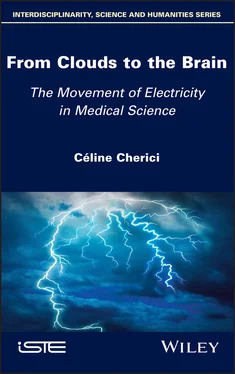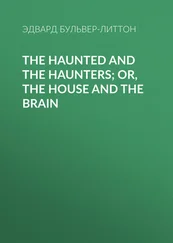Electricity developed as an exploratory science of the central nervous system of control and improvement. This conceptual framework, linked to the current concept of increasing and improving capabilities, triggered a flurry of advertising promoting the merits of electrical accessories capable of improving mores by improving behavior. The fact that electrical treatments were seen as cures for virtually all diseases of the body and mind, from neurasthenia to epilepsy, was a result of this societal imaginary. The term culture, applied to electricity, took on its full meaning:
Such ideas about the hierarchical ordering of the body and society also made sense in light of the connections formed in the early nineteenth century between nervous impulses and other imponderable forces. If nervous impulses acted like electricity, for example, it stood to reason that the nerves existed in a continually active state. Luigi Galvani’s connection between electrical and nervous impulse and Johannes Müller’s law of specific energies both emphasized the extent to which the body could be understood via analogy with machines powered by imponderable forces. [GRE 02, p. 82]
The history of electricity ranges from sensationalism to the moral control of the instincts that lie dormant in every person. From the representation of internal electricity as an indispensable ingredient of life to external electricity applied to moral disorders, we pass from the myth of Frankenstein to that of Hyde between 1803 and 1840. Carpenter (1813–1885) assumed that society was anxiety-provoking, disrupting the links between body and mind, leading to nervous diseases related to the eruption of uncontrollable behavior on the surface of the brain and nerves [CAR 46]. Critical of phrenological localizations, he developed a dynamic and functional brain model, ranging from the most automatic brain layers to those most likely to generate free will. His representations of an organic and hierarchical human nature were based on the evolutionary model developed by Jackson:
On both comparative and anatomical issues he highlighted phrenology’s flaws, and presented an alternative physiology of the mind rooted in anatomical considerations. The human mind was split not into faculties but into levels: automatic reflexes, which were the most basic; instinctual behaviour, of only limited psychological function; and consciousness, the highest level, which was anatomically located in the cerebral cortex. While all cerebral control of the body was mediated in the same way, through the reflex machinery Hall elucidated, there was a key difference between purely reflex and volitional actions, as the latter were dependent on the action of the will. The highest level, consciousness, interacting through the highest centres of the brain, was constituted and acted as a whole: this was the indivisible and non-material aspect of the human mind. [FIN 12b, p. 45]
Electricity was designed as the tool to keep behavioral overflows contained. It focused the hopes of a power that could be mastered by humanity and, acting upon it, would make it possible to discipline the behaviors generated by the most automatic and oldest layers of the brain. Carpenter, in the context of his studies on a physics of a humanity-inclusive world, also argued in favor of the idea that the different forces involved in inorganic processes were modifications of a single life force, itself correlated with the forces at work in matter. Electricity, magnetism, and other forces, including those of the body, would only be the different scales of one and the same energy, the difference then consisting of the devices by which they were manifested and measured. Thus, the mid-19th Century saw a resurgence of mesmerism. The discovery of electromagnetism had as cultural consequences the desire to unify these forces even in the knowledge of the human being on which the medical treatment of mental illnesses depended. This resurgence corresponded to the strong craze for the forces of nature, newly integrated into electrical therapies. In 1845, Thomas Courant, a follower of electric and magnetic medicine, founded the Société Philantropico-Magnétique de Paris as well as a newspaper called L’union magnétique : journal de la Société philanthropico-magnétique de Paris published between 1854 and 1869 [UNI 54–69]. His works, quoted many times by the press, 12 had a magical atmosphere close to mesmerism. The words of Crichton-Browne (1840–1938) reflect the universal role played by electricity since the 19th Century:
We used to explain electricity in relation to matter; now we are trying to explain matter in electrical terms. Could not electricity now be understood through the much more subtle manifestation of a psychic energy that has perhaps always been beyond the reach of research in physics, but in which we live, move and have our being? [CRI 38, p. 187, author’s translation]
After 1840, it became the guarantor of cerebral security by participating in the psychiatrization of moral disorders. Analogies with machines served as theoretical materials for understanding the electrical functioning of the nervous system. At the morpho-functional level, the nerves were considered like electrical wires and conducted instructions from the mind to the body, even if they were recalcitrant. It is in this context that Thomas Laycock’s cerebral-moral considerations on electrical control [LAY 40] came into play:
Thomas Laycock concurred that electricity could prove to be the therapy of choice in treating hysterical women. Electrotherapy could return to normality the bodies of those whom hysteria had transformed from ‘the gentle, truthful and self-denying woman’ into victims of ‘insane cunning, destructiveness, infanticidal impulses, morbid appetites, etc.’. [RHY 02, p. 105]
Laycock was part of this monistic scientific atmosphere where electricity should enable us to understand all the laws of nature, from the phenomena of life to the great terrestrial and cosmic phenomena. Nevertheless, while he drew analogies between the great forces of the universe and mental phenomena, he pointed out that the latter belong to us intrinsically while other phenomena remain external. What did this clarification made in 1863 mean? It appears that Laycock highlighted the fact that while electricity allows us to understand our environment, it also opens up the possibility of knowing ourselves to the depths of our mental schemas, which are themselves of an electrical nature. This electrical definition of our mental sphere complements his remarks on hysteria, a convulsive disease that was the target of medical electricity at the end of the 18th Century:
And it is clear, too, that the primary or essential phenomena of electricity, chemical affinity, heat, light, and even gravity, are just as much beyond the reach of observation as those of mind […]. There is an important difference; however, in favor of mental phenomena in this respect, in the fact that they are in immediate relation with our consciousness, whereas those of all other forces are only in a mediate relationship. [LAY 63, p. 169]
As early as 1840, several representations were at work in the description of the links between the nervous system, consciousness, hysteria and electricity: on the one hand, the woman was considered as the potential victim of her emotions; on the other hand and in a less obvious way, electricity was conceived as the coercive treatment of hysterical disturbances:
The consequences of all this is, the young female returns from school to her home a hysterical, wayward capricious girl; imbecile in mind, habits and pursuits; prone to hysteric paroxysms upon any unusual mental excitement. [LAY 40, p. 142]
He argued for restoring communication between the nervous system and the body through galvanization. Gray matter was compared to a galvanic cell in which an electric current was generated, while white matter was like the electric wires of telegraphs that conducted current within the body. Hysteria was the catalyst for these concerns to the extent that:
Читать дальше












